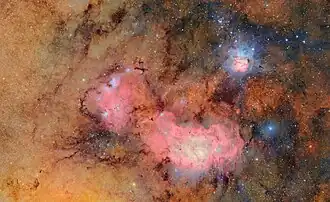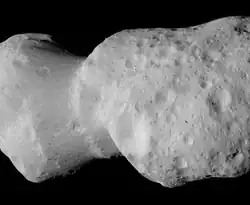GW231123
| Event type | Gravitational wave |
|---|---|
| Date | Detected 23 November 2023, 13:54:30 UTC |
| Duration | 0.1 seconds |
| Instrument | LIGO |
| Distance | 2.2+1.9 −1.5 Gpc |
| Redshift | 0.39+0.27 −0.24 |
| Progenitor type | Binary black hole |
GW231123 was a gravitational wave detected by the two LIGO detectors on 23 November 2023. As of 2025, it is the largest binary black hole merger yet detected, at 225+26
−43 solar masses (M☉) for the final object. One or both of the objects involved in the merger may have been in the black hole mass gap.[1][2]
Characteristics
GW231123 was the result of the merger of a 137+22
−17 M☉ black hole and a 103+20
−52 M☉ black hole creating a new intermediate-mass black hole. It occurred at an estimated distance of 2.2+1.9
−1.5 Gpc. They have unusually large spins, with a magnitude of 0.9+0.10
−0.19 and 0.8+0.20
−0.51 for the two components respectively.[3]
Science results
The high mass of both components of the binary black hole raises questions on its formation, as some very massive stars are thought to undergo pair-instability supernova, which do not leave a remnant; this is thought to result in a gap in the black hole mass distribution between 60 and 130 M☉ (although there is some uncertainty on the limits). This suggests that the system has undergone a more complex process, e.g. with the black holes possibly resulting from earlier mergers, which is known as a "hierarchical" merger (this hypothesis is in particular supported by the high spins of the black holes).[3]
As the signal is extremely short, it is also possible that the signal originates from another type of system, such as cosmic strings, although it is considered unlikely.[3]
References
- ^ Conover, Emily (July 13, 2025). "The biggest black hole smashup ever detected challenges physics theories". Science News.
Gravitational waves reveal the birth of a black hole with about 225 times the mass of the sun
- ^ Sample, Ian (2025-07-13). "Scientists detect biggest ever merger of two massive black holes". The Guardian. ISSN 0261-3077. Retrieved 2025-07-14.
- ^ a b c The LIGO Scientific Collaboration; the Virgo Collaboration; the KAGRA Collaboration (2025). "GW231123: a Binary Black Hole Merger with Total Mass 190-265 M☉". arXiv:2507.08219 [astro-ph.HE].



